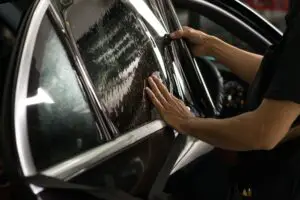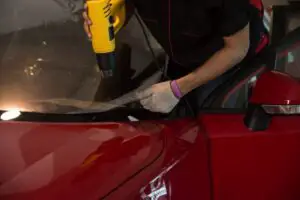Window tinting laws usually limit people on how dark their tints can get and how reflective they are.
Alongside these two major areas, there are various and smaller rules that you must follow if you want to stay away from law enforcement.
Nebraska window tint laws have set the base VLT requirement at 35% or more.
Some vehicle types offer decent relaxations by having their VLT requirements drop to 20%, while others remove their restrictions entirely.
Windshields rules are kept constant by having them to use non-reflective tints that are above the AS 1 line.
I will go over all these rules in detail and answer any questions or concerns you may have, so make sure to read the article.
Table of Contents
- 1 How Much Tint Darkness Is Legal In Nebraska?
- 2 Window Tint Reflection And Tint Colors
- 3 Medical Exemption Of Window Tint Laws In Nebraska
- 4 Get A Certified Sticker From The Company
- 5 Other Window Tint Law Rules And Regulations In Nebraska
- 6 Cost Of Car Window Tint In Nebraska
- 7 Frequently Asked Questions
- 8 Conclusion
How Much Tint Darkness Is Legal In Nebraska?

Excluding the windows where tint requirements are null, the lowest VLT requirements for tints in Nebraska are 20%.
For windows like the front seat side windows, the tints requirements are set at 35% VLT, a 15% increase.
Tint Darkness Limit For SUVs And Vans
Starting with the tint rules for sports utility vehicles and vans, you will see that these vehicles have much fewer restrictions than sedans.
This is not the case for the windshield with the same level of requirements in all vehicles. These requirements are that you cannot use any reflective tints on the windshield.
If you apply a non-reflective tint on the windshield, you will have to limit it above the manufacturer’s AS 1 line.
The front-seat side windows also have universal rules in Nebraska, with the window tints being restricted to having at least 35% of light pass through them.
These rules are immediately removed for the back seat side windows, which have no limitations whatsoever.
This is the case for rear windows, which means that you can apply any window tints you want on these windows without fearing their tint darkness.
Tint Darkness Limit For Sedans
Now I will talk about the rules of tinting windows for sedans, and you will so how restricted they are compared to SUVs and vans.
1. Front Windshield
The windshield can also be applied with tints as long as they are non-reflective and are limited to being above the AS 1 line.
2. Front Seat Side Windows
The front-seat side windows across all vehicles must allow at least 35% of outside light to enter the car.
3. Rear Window
The restrictions for the rear window are slightly less than that of the front seat side windows, reducing the VLT requirements from 35% to 20%.
4. Back Seat Side Windows
This is the same case for the back seat side windows, which must also have 20% of outside light enter the vehicle.
Window Tint Reflection And Tint Colors
Nebraska has also set various rules regarding the amount of light the tints can reflect and what colors they are allowed to have.
- All cars and vehicles must maintain tints that cannot reflect more than 35% light on their front-seat side windows.
- All vehicles’ back seat side windows are also required to not reflect more than 35% of any light.
- The state of Nebraska has allowed the use of many colors when it comes to tinting your windows.
- There are a few colors that the state has banned. These colors include:
– Red
– Yellow
– Amber
Medical Exemption Of Window Tint Laws In Nebraska

The average person should be easily able to follow the rules and regulations set by the state of Nebraska.
This is in part due to their relatively low tint requirements.
However, there will be a small percentage of people who simply cannot follow these requirements due to medical reasons.
This is because their conditions prevent them from handling the sun’s rays, and instead, they must use stronger and darker tints to shield themselves from the light.
These people will be sad to hear that the state of Nebraska does not allow its citizens any medical exemptions from the law.
This means that even if you have a serious condition, you will be required to follow the rules, just like everyone else.
This prevents a certain amount of people from traveling in cars because they will not be able to deal with the light entering the vehicle.
Get A Certified Sticker From The Company
While the state may not allow any sort of medical exemptions, it also does not require any sort of certifications or legal documents to see whether the tints you have applied to the vehicle are certified or not.
Certification stickers are requirements in certain states as they help law enforcement assess which tints are legal and not.
However, this is not a rule in Nebraska, and you are not required to have any sticker related to the tints of your vehicle.
The same is the case for the film manufacturers, who are not required to show any form of certification that the tint is legal in the state.
Other Window Tint Law Rules And Regulations In Nebraska
Here are the various other laws that are in place in the state of Nebraska and that you must follow.
- There are no side mirror requirements in place in the state of Nebraska.
- You cannot use red, yellow, and amber as tint colors for your vehicles.
- You are not required to have any documents to showcase the legality of your vehicle.
- The state does not allow any medical exemptions.
- There is no tint variance amount. You will be breaking the law if you are even 1% off of the tint requirements set by the state.
Cost Of Car Window Tint In Nebraska
Like other states, you will be looking at around $150 if you want even a basic tint for your vehicle.
This price will only increase if you decide to explore better options, having more quality and a better warranty.
The best quality films, such as ceramic window tints, will cost you $400 or more.
There are various other factors, such as the vehicle type and the number of windows it has, which can affect the overall cost.
All of this aside, if you want a cheaper option, you can purchase a DIY tint kit a swell which should be available for less than $100.
Frequently Asked Questions
Q1. Is 15% Tint Legal In Nebraska?
For the most part, 15% of tints are not legal in Nebraska.
This is because the lowest requirement the vehicles must follow is 20%. You can apply 15% tints only on SUVs’ rear and back seat side windows.
Q2. Are 5% Tints Legal In Nebraska?
Same as the question above, you are only allowed to use 5% tints on the back seat side windows and the rear windows of SUVs.
Aside from these windows, you cannot apply the tint without it being illegal.
Q3. Is Limo Tint Legal In Nebraska?
You should try and avoid limo tints as well, as they too are quite dark and will most likely be illegal on sedans and the front seat side windows for SUVs.
You can apply them to the windows mentioned above for SUVs.
Q4. Can I Get Pulled Over For Tint In Nebraska?
Yes, you can get pulled over if the police think you are breaking the law and will conduct a test to check whether the tints are legal or not.
Q5. How Much Is A Tint Ticket In Nebraska?
Tint ticks classify as a class V misdemeanor, and if you are given a tint ticket, you can get a fine that can easily go up to $100 per tinted window.
Conclusion
Nebraska tint laws are quite restrictive and do not offer a lot of convenience to the people other than the fact that they do not require any certifications to show whether the tints are legal.
With that being said, it is extremely disappointing to see that they have not implemented any form of medical exemption whatsoever.
Regardless of how you feel about these rules, they are the law and must be followed, and now that you have read this article, you should have a good understanding of how the law operates, and you should be easily able to follow the rules of the state.

I am Tahir Azam, and I have been writing amazing articles for TaxiHack for as long as I can remember. I know everything that is to know when it comes to automobiles and is always on top of industry news and developments. While I am not an expert by any means, I pride myself on knowing the ins and outs of many different problems and, of course, their solutions. The articles on our website are some of the best and well-researched content that you will find, and I spend countless hours making sure this remains to be true. This is why I ask you to take your time out and read some of my articles, especially if you find a topic that resonates with you or is something you are looking into. This way, you will find the perfect mix of information and tips on your desired topic. Learn more about Tahir.




